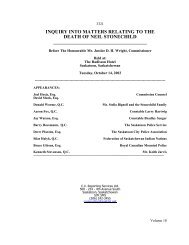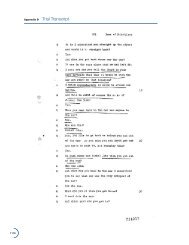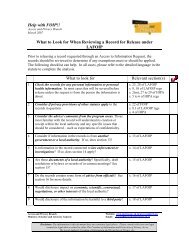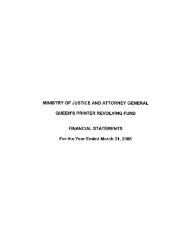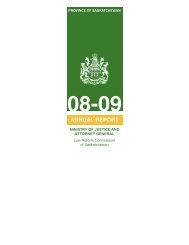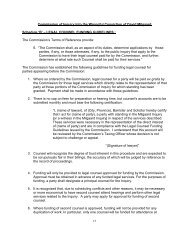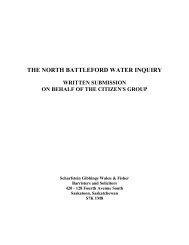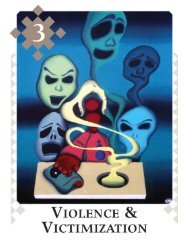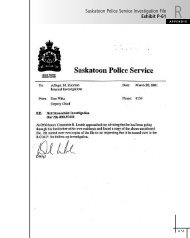Chapter 7 Summary of Findings and Recommendations
Chapter 7 Summary of Findings and Recommendations
Chapter 7 Summary of Findings and Recommendations
You also want an ePaper? Increase the reach of your titles
YUMPU automatically turns print PDFs into web optimized ePapers that Google loves.
<strong>Chapter</strong> 7 <strong>Summary</strong> <strong>of</strong> <strong>Findings</strong> <strong>and</strong> <strong>Recommendations</strong><br />
4. Albert Cadrain was rational <strong>and</strong> showed no overt indications <strong>of</strong> being mentally ill at the time<br />
he gave his statement <strong>of</strong> March 2, 1969 <strong>and</strong> when he testified at trial. His mental illness, first<br />
diagnosed in 1973, was not apparent to investigators or prosecutors prior to David Milgaard’s<br />
conviction (even if it existed before then). The police were justified in relying upon Cadrain <strong>and</strong><br />
his evidence was h<strong>and</strong>led appropriately throughout.<br />
(ii) Initial Statements <strong>of</strong> Nichol John <strong>and</strong> Ron Wilson<br />
5. The initial police statements <strong>of</strong> Ron Wilson <strong>and</strong> Nichol John did not include complete details <strong>of</strong><br />
their activities on the morning <strong>of</strong> January 31, 1969. Continued questioning <strong>of</strong> these witnesses<br />
by the police was justified.<br />
6. The decision to have Inspector Art Roberts <strong>of</strong> the Calgary Police Service conduct a polygraph<br />
test on Ron Wilson <strong>and</strong> Nichol John was reasonable. The summary prepared by Detective<br />
Sergeant Raymond Mackie was intended as an investigative aid <strong>and</strong> not as a blueprint for<br />
a case police were constructing against David Milgaard. The allegation that the Mackie<br />
<strong>Summary</strong> was prepared as a script for the police to follow in obtaining evidence from John<br />
<strong>and</strong> Wilson is without foundation.<br />
7. After their initial police statements <strong>and</strong> prior to being interviewed by Art Roberts, Ron Wilson<br />
<strong>and</strong> Nichol John provided the police with further details <strong>of</strong> their activities on January 31,<br />
1969. In particular, they told the police they stopped a woman for directions, that shortly<br />
thereafter their vehicle became stuck in the vicinity <strong>of</strong> the murder <strong>and</strong> that David Milgaard <strong>and</strong><br />
Wilson left the vehicle in separate directions looking for help. Their accounts were generally<br />
consistent with what Milgaard had told his trial counsel, except with respect to the length <strong>of</strong><br />
time Milgaard was away from their stuck vehicle. Wilson said it was 15 minutes, Milgaard said<br />
it was a short time <strong>and</strong> John said she was unable to recall.<br />
(iii) Ron Wilson<br />
8. In his May 23, 1969 interview with Art Roberts, Ron Wilson did not initially implicate David<br />
Milgaard in Gail Miller’s murder. Roberts conducted a polygraph examination testing the<br />
veracity <strong>of</strong> Wilson’s evidence, <strong>and</strong> then advised Wilson that the polygraph showed he was<br />
not being truthful in answering certain questions relating to Milgaard’s involvement in Miller’s<br />
murder. Wilson responded by changing his evidence to directly implicate Milgaard. He<br />
provided new information, which included an alleged confession by Milgaard, an identification<br />
<strong>of</strong> the murder weapon <strong>and</strong> an observation <strong>of</strong> blood on Milgaard’s clothing. Roberts did not<br />
test the truthfulness <strong>of</strong> Wilson’s new inculpatory evidence by polygraph.<br />
9. Ron Wilson was turned over to the Saskatoon Police to whom he provided two written<br />
statements verifying the new information he disclosed to Art Roberts after the polygraph<br />
session.<br />
10. The inculpatory evidence Ron Wilson provided to Art Roberts <strong>and</strong> the Saskatoon Police after<br />
the polygraph test is now known to have been unreliable.<br />
11. The Commission lacks evidence to conclude that Art Roberts resorted to outright coercion<br />
during his interview with Ron Wilson, but whatever he said to him did not produce the truth. In<br />
the course <strong>of</strong> the polygraph examination <strong>and</strong> interview, Roberts somehow caused Wilson to<br />
tell him what Roberts thought to be the truth.<br />
400



